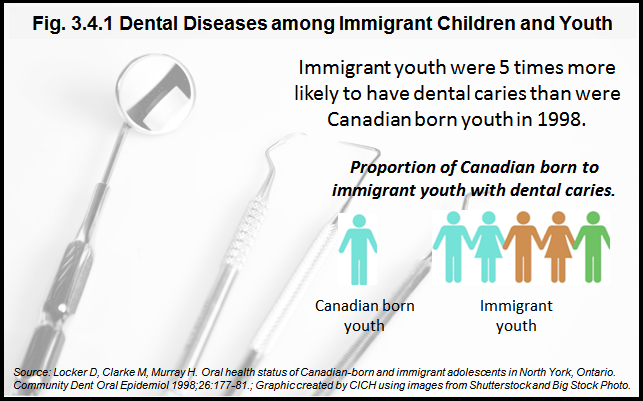Dental Diseases among Immigrant Children and Youth

Evidence indicates that immigrant youth are at greater risk of having dental disease – in fact they were five times more likely to have dental caries than were Canadian born youth. One in five immigrant youth required restorative dental care for these caries – compared to less than 4% of Canadian born youth.1 While the longer immigrant children and youth live in Canada, the less likely they are to have dental disease, they continue to have higher rates than Canadian born young people.
Recent evidence shows that the development of dental caries is increasing in African and Asian countries – it is thought that this is due to increasing consumption of sugar and lack of topical fluorides in toothpastes and professional dental products.2
Poor oral health among immigrant children and youth may result from poor nutrition and diet, lack of fluoridated water, poor dental hygiene practices and limited dental care in the past. This is particularly true for refugee children and youth who are less likely than children and youth from other immigrant classes to have received dental care in the native countries.
1Locker D, Clarke M, Murray H. Oral health status of Canadian-born and immigrant adolescents in North York, Ontario. Community Dent Oral Epidemiol 1998;26:177-81. Cited in Pottie K, Greenaway C, Feightner J, et al. Evidence-based clinical guidelines for immigrants and refugees. CMAJ 2011;183:E824-925.
2Petersen PE, Bourgeois D, Ogawa H, et al. The global burden of oral diseases and risks to oral health. Bull World Health Organ 2005;83:661-9. Cited in Pottie K, Greenaway C, Feightner J, et al. Evidence-based clinical guidelines for immigrants and refugees. CMAJ 2011;183:E824-925
3Caring for Kids New to Canada. Oral Health Screening. http://www.kidsnewtocanada.ca/screening/oral-health
Implications
Children and youth arriving from countries with limited dental care and where diets are high in sugar are at the highest risk for dental disease. Screening and referral for dental disease can facilitate treatment and prevention. Patients are twice as likely to go for dental treatment when they are actively examined and referred by a physician. Tooth-brushing twice daily with fluoridated toothpaste is effective in reducing the risk of dental decay.
Canadian Immigrant Health Guidelines recommend that clinicians screen all immigrant children and youth for dental pain by asking, “Do you have any problems or pain with your mouth, teeth or dentures?”. All immigrant children and youth should be screened for obvious dental caries and oral disease by examining their mouth with a penlight and tongue depressor. Children and youth with obvious dental disease should be referred to a dentist or oral health specialist. The guidelines recommend that primary care practitioners treat dental pain with nonsteroidal anti-inflammatory drugs (such as aspirin and ibuprofen) and refer patients to a dentist.4
4Pottie K, Greenaway C, Feightner J, et al. Evidence-based clinical guidelines for immigrants and refugees. CMAJ 2011;183:E824-925
